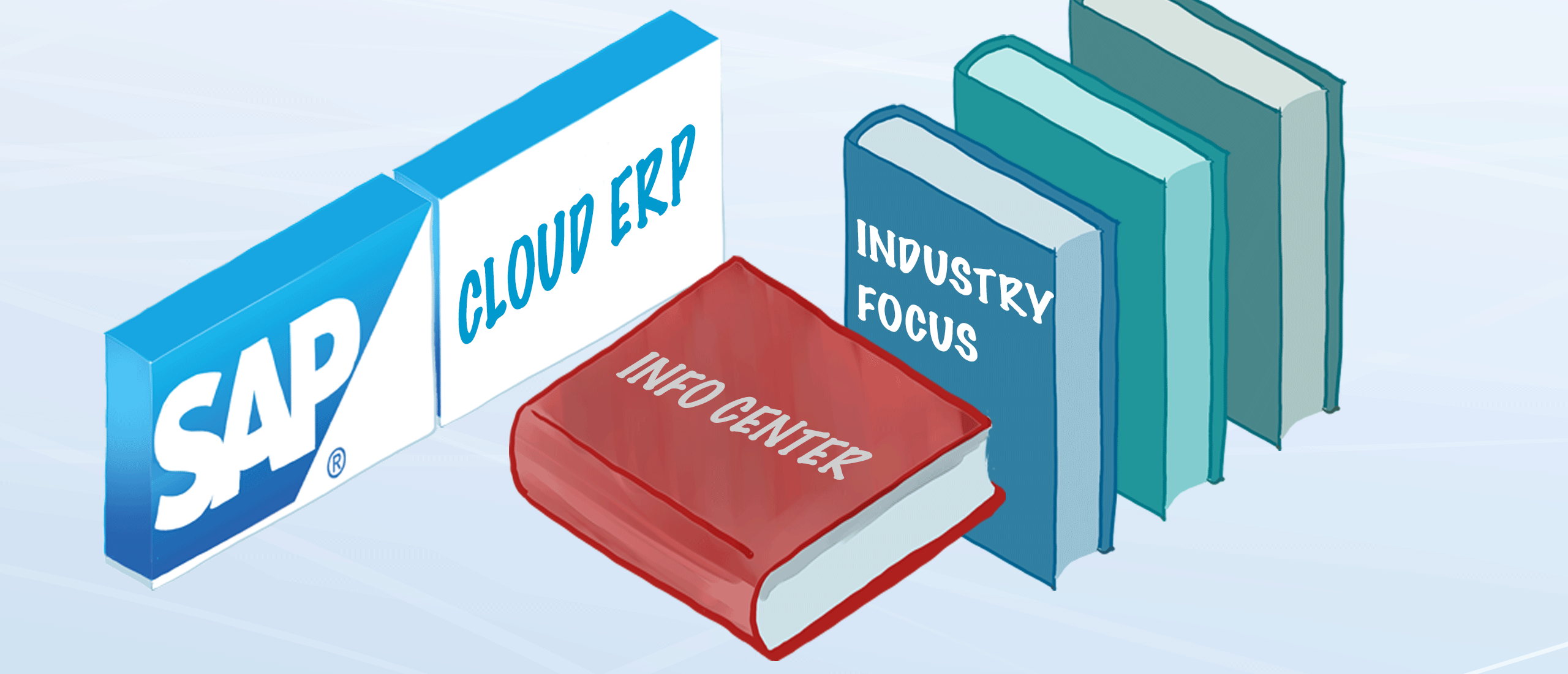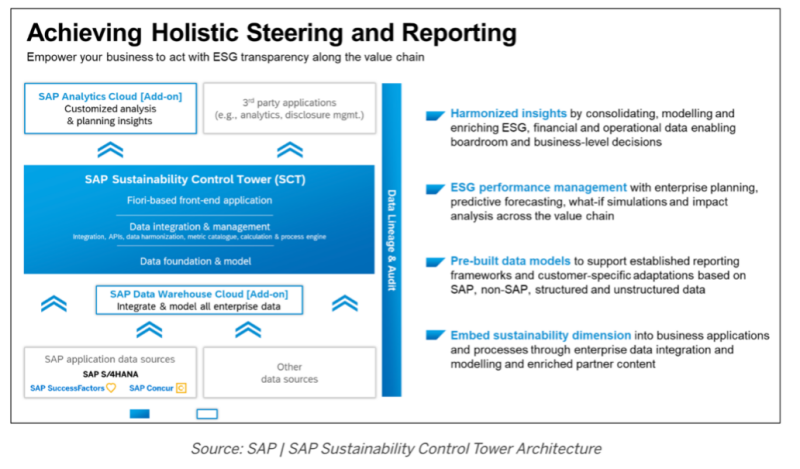
SAP Sustainability Control Tower
Introduction
SAP Sustainability Control Tower (SCT) is a software-as-a-service solution designed to help businesses monitor and manage their sustainability performance. It enables organizations to track, analyze, and optimize their sustainability initiatives, including environmental, social, and governance (ESG) metrics.
The solution helps customers to evolve their sustainability reporting to an ongoing holistic steering.
It provides real-time insights into the sustainability performance of an organization’s operations, suppliers, and products. Data can be pulled from SAP and non-SAP systems to automate data collection and reduce manual data input – all in one single source of truth.
With pre-built content based on the most prominent sustainability standards like GRI, WEF, TCFD, CSRD, the EU Taxonomy and more, customers can establish a robust and auditable ESG Reporting.
Besides reporting, the solution also enables sustainability steering to improve its own sustainability performance by making informed and right decisions. This enables users to set sustainability targets, monitor progress, and take corrective actions to ensure compliance with regulatory requirements and stakeholder expectations.
With SAP Sustainability Control Tower, businesses can:
- Streamline data collection & management: Integrate your systems of records directly into SAP Sustainability Control Tower to eliminate errors, increase the speed of reporting, and improve the audit trail.
- Enhance sustainability reporting: The solution helps businesses generate sustainability reports and disclosures that are accurate, transparent, and compliant with regulatory requirements and industry standards.
- Monitor and analyze sustainability data: The solution provides visibility into an organization’s sustainability performance, enabling businesses to identify areas of improvement and take corrective actions.
Architecture SAP SCT
The architecture of the Sustainability Control Tower is designed to provide businesses with a holistic view of their sustainability performance. The solution integrates data from various sources, including internal systems, external databases, and third-party applications. Currently, the solution has a turnkey integration into SAP S/4HANA Cloud for Finance and can upload data manually via .csv or .xlsx files. Further integrations are planned and can be seen on the roadmap.
The architecture of SAP Sustainability Control Tower is highly scalable and flexible, enabling businesses to quickly adapt to changing business requirements and regulatory frameworks. The solution is also highly secure and compliant with industry standards, ensuring that sensitive data is always protected.
The architecture of the SAP Sustainability Control Tower can be seen in the following image:

SAP Sustainability Control Tower is a standalone solution – no prerequisites needed – and is built up with the following elements:
Data Foundation: Sustainability is complex. Therefore, data cannot be found in one single system. As a data foundation, a SAP HANA Cloud database is used. SAP HANA Cloud is an in-memory database that enables businesses to process large volumes of data in real-time, plus providing instant insights that can be used to inform decision-making and drive business performance.
Data Integration and Management: The Calculation and Process Engine (CPE) is used for data integration and management. This calculation engine has different interfaces where data can be modeled according to specific customer needs, from guided processes with approver workflows to solid data modeling capabilities to report creation. This enables businesses to gain insights into their performance drivers, optimize operations, and make informed decisions.
Frontend: SAP Fiori is used as a frontend. The most crucial benefit of SAP Fiori as a frontend is its ability to provide a modern, intuitive, and user-friendly interface for accessing and interacting with SAP business applications.
When we look at the solution holistically, we can see some significant benefits resulting from the architecture of the SAP Sustainability Control Tower, which is:
- Modular, flexible, agile & business friendly sustainability data management platform
- Single Source of Truth for sustainability data along the entire value chain, bringing together financial with non-financial data
- Direct data integration and manual data input
- Best-in-class calculation and allocation engine
Capabilities SAP SCT
Record: Data Management - Data collection is a critical component of sustainability reporting, and SAP Sustainability Control Tower offers a range of tools and features designed to streamline this process. The solution can integrate data from internal systems, external databases, and third-party applications, making collecting data on a wide range of sustainability metrics easy.
In addition to its data collection capabilities, SAP Sustainability Control Tower includes a sustainability metric catalog, providing businesses with a comprehensive list of commonly used sustainability metrics. This catalog includes carbon emissions, energy consumption, water usage, waste generation, and more metrics, making it easy for businesses to track their sustainability performance across various areas.
The sustainability metric catalog in SAP Sustainability Control Tower is highly customizable, enabling businesses to add or remove metrics as needed to align with their specific reporting requirements. This flexibility ensures that businesses can accurately report their sustainability performance, regardless of industry or location.
Flags and threshold values: To ensure that data quality is maintained, the SAP Sustainability Control Tower includes flags and threshold values that can be set to identify data outside of expected ranges. This helps to ensure that data is accurate and reliable and that any issues can be identified and addressed quickly.
Report: Performance Insights - Once data has been collected, SAP Sustainability Control Tower gives businesses insights into their sustainability performance. With the solution, business users can continuously monitor actual data against target data, highlighting any areas where performance is lagging behind expectations. This helps businesses identify improvement areas and take corrective action before issues escalate.
Act: Ambitions - One of the solution's key features is its Ambitions capabilities, which enable businesses to set ambitious targets, track their progress, and simulate different scenarios to identify the most effective strategies for achieving their sustainability goals. The solution provides real-time insights into performance against these targets, making it easy to identify areas where improvement is needed.
Simulation Capabilities: To support strategic decision-making, SAP Sustainability Control Tower also includes Simulation Capabilities. Businesses can simulate different scenarios to test the potential impact of different sustainability initiatives, helping to identify the most effective strategies for achieving their sustainability goals. This helps businesses to make data-driven decisions and maximize the impact of their sustainability initiatives. More to come within the next blog post, so stay tuned!
In summary, the most important benefits of the capabilities of the SAP Sustainability Control Tower are:
- Guided Processes for data collection and gathering
- Pre-built data models, processes, reports & KPIs according to Frameworks such as GRI, TCFD, EU Taxonomy and many others
- User-friendly Reports & Dashboards
- Target Setting & Performance Management Capabilities
